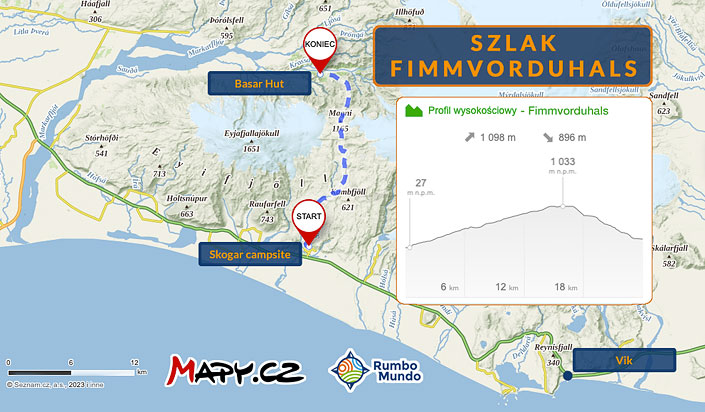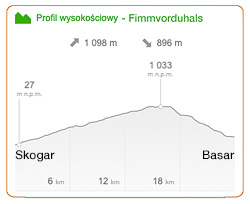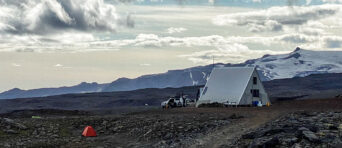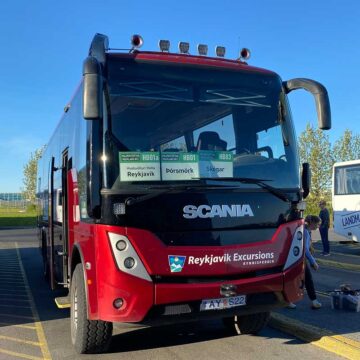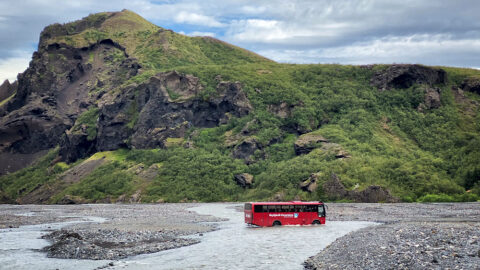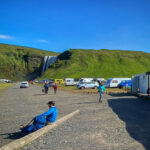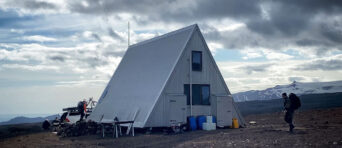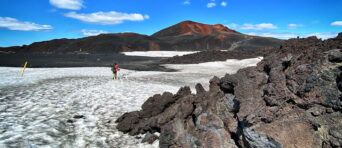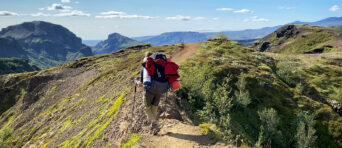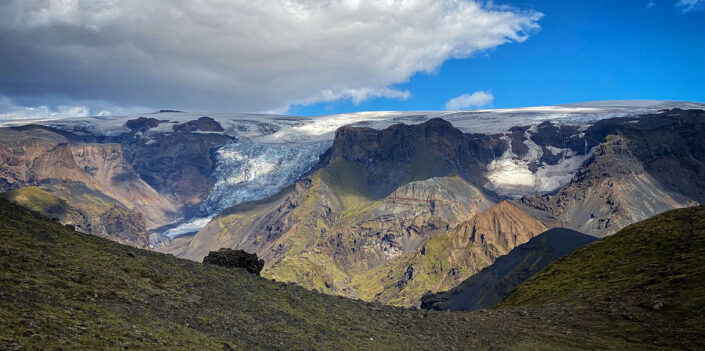In the separatearticles you will read about the trails north of Fimmvorduhals – Laugavegur and Hellismannaleid – and all the shelters and campsites on these trails.
Fimmvörðuhals is a beautiful two-day hiking trail in southern Iceland. In many ways, it is even more attractive than its famous “neighbor” – the Laugavegur trail. Sections of this trail are also worth seeing as part of a typical car tour.
Course and profile of the Fimmvorduhals trail
The Fimmvorduhals trail takes its name from the pass through which it passes. It is a high mountain pass between the peaks of two glacier-covered volcanoes. The larger of the two is Mýrdalsjökull, and the smaller, but more famous, is Eyjafjallajökull (the same one that halted air traffic over Europe for several weeks with its 2010 eruption). The Fimmvorduhals Pass divides the trail into two, relatively equal parts – north and south.
Nominally, therefore, this is a route for 10 to 12 hours – after all, you also have to eat at some point, and stop occasionally at a nice view. On the other hand, a day in Iceland in summer lasts up to 20 hours, so many people walk this trail “at once”. – they start really early in the morning and finish towards evening. The fastest ones are able (supposedly) to walk south to Skogar in time for the 3pm bus…
However, for most people it is a better idea to split the route in half and stay overnight at the pass. You can then choose between the Fimmvorduskali hut and the Baldvinsskali hut and campsite. Both huts are very close to each other and practically on the pass itself. Even if you walk only about 3 GOT/h, you will still make it to them before night. We’ve devoted separate detailed articles to both huts (linked above), and you’ll find highlights about them later in this article. It took our family about 7 hours to climb (in great weather) from Skogar to Baldvinsskala (plus an hour to see Skogafoss), and as much as 8 hours to walk from Baldvinskala to Basar Hut (though that included a stop for breakfast at Fimmvorduskala, which I highly recommend in general). From this perspective, crossing the entire Fimmvorduhals trail under 10 hours is really quite a feat.In the separatearticles you will read about the trails north of Fimmvorduhals – Laugavegur and Hellismannaleid – and all the shelters and campsites on these trails.
What to see on the Fimmvorduhals trail
Fimmvorduhals is an extremely scenic trail. Walking from the south, we start with more than a dozen smaller and larger waterfalls on the Skoga River. Some of them can successfully compete in their attractiveness even with the largest and most famous Skogafoss, from which this trail begins. Certainly, this “day of waterfalls” is a huge advantage of the trail and the reason why it is really worth going .
If you came to Skogar by car to see the famous Skogafoss, COMPLETELY walk at least a bit up the Fimmvorduhals trail. In about 45 minutes (maximum 1 hour) you will reach the beautiful Skalabrekkufoss, passing several other waterfalls along the way. It’s really worth it!
The way to the last of the waterfalls by the trail (there are as many as 20 here in total) and back is almost 15 km (20 GOT’s), so if you do not walk very fast, this is a route for 5 to 7 hours (total round trip). Continuing north, we reach the Fimmvorduhals Pass, which is quite high for Iceland. Its 1,000 meters above sea level is colossally impressive, as the base of the mountains among which the pass lies rises directly from the nearby ocean (in a straight line it is only about 15 km). Thus, the difference in height between the Skogar campground and this pass is almost identical to that which separates the center of Zakopane from the top of Giewont
From the pass – in good weather – there are beautiful views in all directions. The most interesting view from here is the summit of Eyjafjallajokull and the Skogar valley itself. Finally, north of the pass, in the Godaland region, we enjoy our eyes with beautiful views of the peaks, valleys and canyons of the Godaland and Thorsmork regions. These are absolutely and by far the most beautiful views of the Krossy Valley and the surrounding mountains. The views of Thorsmork that we will see from the more famous and popular Laugavegur trail do not “compete” at all with those seen from Fimmvorduhals. Attractive panoramas of Thorsmork can still be found at the top of Valahnukur and on the trails around Tindfjoll, but the views from the northern part of the Fimmvorduhals trail, however, are the best (for more on the most interesting trails in Thorsmork and Godaland, see the articles on the campsites from which these trails start: Basar Hut and Langidalur).In addition to beautiful panoramas of glacier-covered mountains, you will also see the Magni and Modi (isl. Móði) craters in this part of the trail. Their names come from the names of Thor’s sons, and the craters themselves were formed and spit lava between March 20 and April 13, 2010. – During the aforementioned eruption of Eyjafjallajokull.
In the lower / farther part of the trail, two beautiful canyons – Hvannargil and Strakagil – are of particular interest. The Fimmvorduhals trail does NOT pass through them, but you can turn off the red trail to Hvannargil, and from the Basar Hut campsite you can take a separate trail to Strakagil.
IFyou’ve come to Thorsmork by car and the weather is beautiful and sunny, then you MUST hike the Fimmvorduhals trail to the Magni and Modi craters and return from there via the trail through Hvannargil. This is probably the most beautiful 1-day hiking trail in all of Iceland! (For details, see the Basar Hut article)
How to get to the Fimmvorduhals trail
Both the northern and southern ends of the Fimmvorduhals trail are relatively easy to get to. Unfortunately, getting from Skogar is a bit more difficult.
Getting to/from Skogar
You can get to Skogar (the southern end of the trail) either by car or by bus from Reykjavik. The bus TO Skogar goes very well, as it starts from Reykjavik first thing in the morning (Laugardalur campground: 6:30, BSI station: 7:00) and arrives in Skogar at 9:45, just in time to go to the trail. Unfortunately, the return route is realized only by the same one bus. As a result, it starts from Skogar quite early – scheduled at 10:15, but to make matters worse it has a 6h break in Hvolsvollur, so it doesn’t reach Reykjavik until 7:30 pm (BSI) or 8 pm (Laugardalur campground). So it takes a full day to return, and the stop in Hvolsvollur is really hard to use for any interesting activities.Czasem (sic!) and without warning or announcement the bus from Skogar goes straight to Reykjavik, without a long stop in Hvolsvollur. Unfortunately, this is impossible to plan or predict ?♂️
One sure saving grace here is the state buses – Straeto. Line 51 (to/from Hofn) departs from Skogar towards Reykjavik at 16:25 and arrives as early as 18:45 (on Saturdays and Sundays: 15:07 -> 17:24), but:
- goes neither to BSI nor to the campground, but to Mjódd station (eastern Reykjavik);
- requires a transfer in Selfoss (although it’s a b. quick/short transfer);
- it is not possible to reserve a seat for this bus (usually there are seats, but not always, unfortunately);
For the record: line 51 DO Skogar goes in the middle of the day. Departure from Mjódd station is at 11:30 a.m., and arrival in Skogar (scheduled) at 1:42 p.m. The ride also requires a smooth transfer at the Selfoss-N1 stop. So from a tourist’s perspective, this probably only makes sense if your plane arrives in Keflavik late enough to miss the aforementioned morning buses, but early enough to catch the 11:30 one from Mjodd station. Going out on the trail at 13:42 doesn’t make much sense – it’s probably better to leave it then for another morning. On the other hand, you can then use the remaining half day to hike to the nearby Kvernufoss waterfall or hitchhike to the DC-3 wreck or Seljavallalaug pool.
Getting to/from Thorsmork
You can also get to Thorsmork (including the start of the trail – to Basar Hut) by bus directly from Reykjavik, or by car on your own. Buses leave Reykjavik at 7:00 am and 3:00 pm (from BSI station to all 3 campsites in Thorsmork) and at 7:30 am and 12:30 pm from the city center (City Hall stop, Vonarstraeti 4; these buses do not enter Volcano Huts). All of these 4 buses also stop at Laugardalur campground in Reykjavik at 6:30 a.m., 7:45 a.m., 12:45 p.m. and 2:30 p.m. Return buses leave around 2:30 p.m., 3:15 p.m., 6:00 p.m. and 8:15 p.m. The exact times depend on which campground you want to go from. The times listed are for Langidalur campground. For departure times from Basar Hut and Volcano Huts, see the pages describing those campsites.Thetwo campsites mentioned have quite similar names, but lie in completely different places. Laugardalur is a campground in the center of Reykjavik, right next to the Laugardalslaug pool complex. Langidalur, on the other hand, is a campsite in the Thorsmork region, on the north shore of the Krossa River.
You can also get to Basar Hut in your own car, but it’s essential to have a 4×4 (more on this in the article about Basar Hut).
Drive between Thorsmork and Skogar
Unfortunately, at present (2023) there is only one direct connection between Thorsmork and Skogar: a bus from Southcoast Adventures leaving Basar Hut at 20:30 and arriving in Skogar at 22:00. If you want to leave your car in Skogar, walk the entire Fimmvorduhals trail and return to your car for the evening (night), this is your only option, other than hitchhiking. It is much easier to arrange a trip to Fimmvorduhals directly from Reykjavik or from Hvolsvöllur (about 110 km east of Reykjavik). From there, we have several (aforementioned) buses each morning and evening going to/from Skogar and Thorsmork.
Accommodation on the Fimmvorduhals trail
At both the ends and the middle of the Fimmvorduhals trail, we have several lodging options available to us.
Accommodations at the southern end of the trail
On the south side, in Skogar, there is a campground as well as a hotel and several guesthouses: Guesthouse Skogafoss, Guesthouse Kverna, Fosstún Guesthouse and Hotel Skoga by EJ.The Skogar campground is not one of the best. It’s actually a separate section of the parking lot below Skogafoss and simple, small sanitary facilities. In addition, it happens that the camping area is waterlogged. In contrast, the guesthouses mentioned are relatively good, but quite expensive. The Skogafoss area is such a popular place that it is better to avoid staying overnight here.
Accommodation at the northern end of the trail
On the northern side, in Thorsmork, the Fimmvorduhals trail formally ends and begins at Basar Hut campground. This is certainly the best ‘base camp’ on the trail and also the first campsite after leaving the trail. However, there are still Langidalur and Volcano Huts campsites available in the close vicinity. All three of these places are close to each other, all offer shelter accommodation and there is also a campground at each of them.
Basar Hut can be reached by one’s own car (but not everyone’s – see the article about the campground), and this is also where we will meet the most Icelandic families. Volcano Huts, on the other hand, offers the highest standard (sauna, restaurant, store, electricity, unlimited showers), and Langidalur is the smallest and most strongly profiled for the so-called qualified tourist – mainly people going to or returning from the Laugavegur trail. A detailed description of each of these places can be found in the linked articles.
Accommodation in the middle of the trail
Fimmvorduhals – as we mentioned at the beginning of the article – is quite a long trail if you want to hike it all at once, in one day. Fortunately, this is not a necessity
On the pass itself, almost perfectly in the middle of the route, lies the Fimmvorduskali hut (isl. Fimmvörðuskáli, 1031 meters above sea level), which also uses the English name Fimmvorduhals Hut. Slightly lower, on the south side of the pass (about 1.5 km to the south and 130 m lower), is the second hut: Baldvinsskáli (896 m above sea level). Both huts on the pass offer accommodation (about ISK 11,000, or PLN 350 per person), and in both it has to be booked well in advance.In neither of them can we use either electricity, a shower or a trash can (with few exceptions). The camping toilets are so-called “dry toilets” – Icelandic versions of our Slawojeks. There is no running water in the huts, but water in cans is provided, for cooking and washing (and possibly minor washing). There is “not always” water in Fimmvorduskala, and the nearest stream is approx. 100 m below
Certainly Fimmvorduskali is much nicer (from the outside) and more nicely located. For that, you can pitch a tent at Baldvinsskáli, which is much cheaper (about 2,000 ISK, or PLN 65 per person) and does not require a reservation, although conditions are truly spartan (the field is very uneven, very windy and without any canteen). This hut also runs a mini-shop.You can read more about the conditions and prices of these accommodations (as well as stores, toilets, etc.) in the linked articles about both huts.
Hazards on the Fimmvorduhals trail
The Fimmvorduhals trail is not only beautiful, but also safe and comfortable. We don’t ford any streams here that force us to take off our shoes (unless shortly after a major rainfall), and usually the biggest challenge is the wind.
Most of the time, the wind only forces us to put on a hat and gloves, and in return provides excellent cooling even on the roughest sections. However, if a storm is currently sweeping through Iceland, you can expect very strong, even hurricane force winds on the pass itself.
Snowfall can also happen anytime, although from mid-June to mid-August it is rather rare. In the highest parts of the trail, moreover, snow piles up in various alcoves, basins and crags throughout the year, but at least from mid-June to mid-August walking on it does not require crampons. The snow is soft and heavily melted. Its consistency is very reminiscent of the one we can also find in the High Tatras in the middle of summer. On the trail we have a few steep passages – mainly the southern approach/descent to the pass itself and the ascent to the plateau from the Thorsmork side – but these are not dangerous. Trekking poles will help, of course, but as much as possible you can walk the trail without them as well.Onlytwo places on the trail really require heightened caution (of course, heightened above the caution that should always be exercised in the mountains anyway). These are the short chains and the so-called cat ridge. Both places are located on the northern part of the trail.
Chains
One place where a higher level of caution should be exercised is when descending/ascending the scree about 2 km north of the pass and directly south of where the more southerly red trail departs to the west (there are two red trails departing west from Fimmvorduhals in this region…). Walking from Thorsmork is the place between the first and second plateaus.It is indeed a very steep section and with a lot of exposure, but it is also very short and protected by ropes and chains. Admittedly, the rock and scree here are quite slippery, and the chains themselves, unfortunately, do not stick to the rock with every catch, but a fit tourist will overcome this place in a dozen seconds (sic!). Unfortunately, this place is “within the range” of day trips from Thorsmork, and the elderly and those unaccustomed to walking on chains overcome this section very slowly and often with undying fear. Therefore, a kind of mountain “traffic jam” can form here.
Cat’s back
The second place requiring attention is the very end of the trail, just before Basar Hut or, for those going south, the beginning of the trail, just after the first, short approach. This section is called Kattarhryggir (English: Cat’s Spine), freely translated: cat’s back. The trail here follows a narrow ridge precisely, with a lot of exposure in both directions. In good, dry weather, it’s just a narrow path with beautiful views (although we don’t really have a way to admire them, as we constantly have to look under our feet). On the other hand, in rainy weather or just after a heavier rainfall, you have to be very, very careful here not to slip, because the descent downhill would certainly end unhappily.What to add to a trip to Fimmvorduhals
The Fimmvorduhals trail is often treated as an ‘add-on’ to the longer, neighboring Laugavegur trail. And indeed it works well in this role (more: Laugavegur – Iceland’s most beautiful trail). In addition, it is also really worth combining it with 1 or 2 days spent on the trails in Thorsmork and Godaland (see more about them in the articles on Basar Hut and Langidalur). Such an extra day (or two) also give you valuable flexibility in planning the main route if the weather breaks. On the Skogar side, in addition to the famous Skogafoss itself, it’s worth setting aside some time to see the Kvernufoss waterfall. It’s a very nice waterfall, and you can read more about it in the article Skogafoss – a spectacular waterfall on the south coast. You can also try to get (hitchhike?) to the DC-3 wreck to the west and/or to the Seljavallalaug basin east of Skogar.
